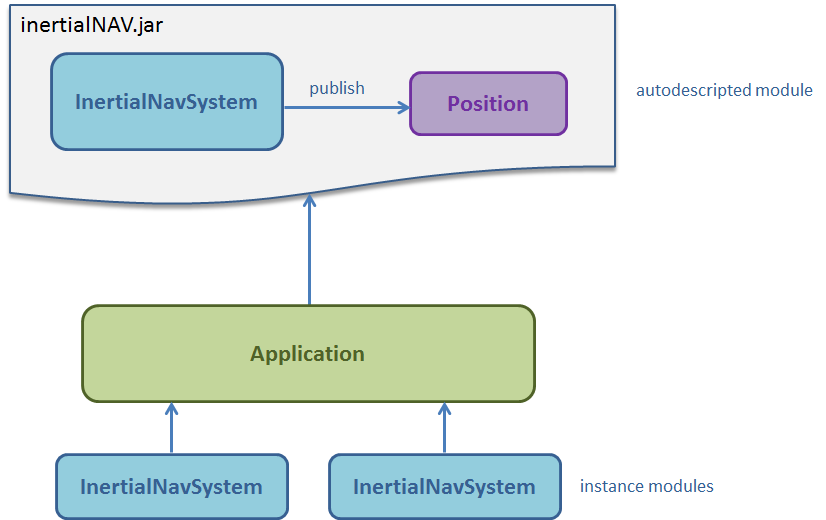Home
Categories
Dictionary
Glossary
Download
Project Details
Changes Log
What Links Here
FAQ
License
Autodescripted modules
1 Use case
2 Defining an autodescripted module
2.1 Interfaces declaration
3 Using an autodescripted module
4 Example
4.1 Simple example
4.2 A more complex example
5 See also
2 Defining an autodescripted module
2.1 Interfaces declaration
3 Using an autodescripted module
4 Example
4.1 Simple example
4.2 A more complex example
5 See also
This article explains how to define and instanciate generic Java modules.
Normally a Java module is just a jar file which is accessed through the module configuration.
In that case all of the following definitions must be defined in the configuration:

To define an autodescripted module, you just have to create a jar file containing the code, and specify the Manifest for this module, which will define:
Interfaces are declared exactly as for a regular module. Note that by default:
Module instances are Java modules which are instances of autodescripted modules. They don't have any implementation because they instanciate their associated autodescripted module.
The tacticalEnv model Application allows to maintain a data store from datas provided by a tacticalEnv Application.
Use case
You can see autodescripted modules as classes which you can instanciate.Normally a Java module is just a jar file which is accessed through the module configuration.
In that case all of the following definitions must be defined in the configuration:
- The Module path which is the class which will be instanciated for the Module at the initialization of the framework
- The Module entry points which are the methods which will be called for each notification
- The Services interface for the module
- The services configuration for the Services used in the application
- The types configuration for the Types used in the application

Defining an autodescripted module
Main Article: Defining an autodescripted module
To define an autodescripted module, you just have to create a jar file containing the code, and specify the Manifest for this module, which will define:
- Mandatory: The application configuration. See Defining the module configuration
- Optional: The services configuration for the Services used in the module
- Optional: The types configuration for the Types used in the module
- Optional: The module version
Interfaces declaration
Main Article: Autodescripted modules interfaces declaration
Interfaces are declared exactly as for a regular module. Note that by default:
- If no interfaces are specified for a Module instance, the interfaces declared for the autodescripted module will be used
- if interfaces are specified for a Module instance, these interfaces will be used rather than those specified for the autodescripted module
Using an autodescripted module
Main Article: Module instances
Module instances are Java modules which are instances of autodescripted modules. They don't have any implementation because they instanciate their associated autodescripted module.
Example
Simple example
The following definition specifies the manifest for an autodescripted module:Modules: org/da/protoframework/tacticalenv/resources/application.xml Types: org/da/protoframework/tacticalenv/resources/types.xml Services: org/da/protoframework/tacticalenv/resources/services.xmlWith the following specification for the
application.xml applications configuration:<application name="publishAppli"> <modules> <module name="PublishModule" > <implementation path="org.da.samples.protoframework.publish.PublishModule" > <initEntryPoint method="init" /> <defaultReceiveEntryPoint method="subscribe" /> </implementation> <interfaces> <eventReceived service="event1"/> <eventSend service="event2"/> </interfaces> </module> </modules> </application>If the autodescripted module is defined in the
MyModule.jar file, we can use this autodescripted module in the following instance:<application name="MyAppli"> <deployment> <lib url="MyModule.jar" /> </deployment> </application>
A more complex example
Main Article: Bundling tacticalEnv Applications
The tacticalEnv model Application allows to maintain a data store from datas provided by a tacticalEnv Application.
<applications> <application name="tacticalenv"> <deployment> <lib url="tacticalEnv.jar" /> <lib url="tacticalEnvModel.jar" /> </deployment> </application> </applications>
See also
- Autodescripted modules interfaces declaration: This article explains how interfaces declaration are handled in autodescripted modules
- Autodescripted modules tutorial: In the autodescripted modules tutorial, we present how to define and use an autodescripted module
- Java modules: Java modules are the default modules type
×
![]()
Categories: concepts | development